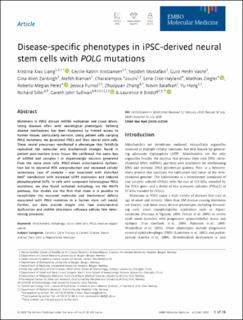| dc.contributor.author | Liang, Xiao | |
| dc.contributor.author | Kristiansen, Cecilie Katrin | |
| dc.contributor.author | Mostafavi, Sepideh | |
| dc.contributor.author | Vatne, Guro H. | |
| dc.contributor.author | Zantingh, Gina | |
| dc.contributor.author | Kianian, Atefeh | |
| dc.contributor.author | Tzoulis, Charalampos | |
| dc.contributor.author | Høyland, Lena Elise | |
| dc.contributor.author | Ziegler, Mathias | |
| dc.contributor.author | Perez, Roberto Megias | |
| dc.contributor.author | Furriol, Jessica | |
| dc.contributor.author | Zhang, Zhuoyuan | |
| dc.contributor.author | Balafkan, Novin | |
| dc.contributor.author | Hong, Yu | |
| dc.contributor.author | Siller, Richard | |
| dc.contributor.author | Sullivan, Gareth | |
| dc.contributor.author | Bindoff, Laurence | |
| dc.date.accessioned | 2021-03-15T13:44:15Z | |
| dc.date.available | 2021-03-15T13:44:15Z | |
| dc.date.created | 2020-08-27T11:34:22Z | |
| dc.date.issued | 2020 | |
| dc.identifier.issn | 1757-4676 | |
| dc.identifier.uri | https://hdl.handle.net/11250/2733452 | |
| dc.description.abstract | Mutations in POLG disrupt mtDNA replication and cause devastating diseases often with neurological phenotypes. Defining disease mechanisms has been hampered by limited access to human tissues, particularly neurons. Using patient cells carrying POLG mutations, we generated iPSCs and then neural stem cells. These neural precursors manifested a phenotype that faithfully replicated the molecular and biochemical changes found in patient post‐mortem brain tissue. We confirmed the same loss of mtDNA and complex I in dopaminergic neurons generated from the same stem cells. POLG‐driven mitochondrial dysfunction led to neuronal ROS overproduction and increased cellular senescence. Loss of complex I was associated with disturbed NAD+ metabolism with increased UCP2 expression and reduced phosphorylated SirT1. In cells with compound heterozygous POLG mutations, we also found activated mitophagy via the BNIP3 pathway. Our studies are the first that show it is possible to recapitulate the neuronal molecular and biochemical defects associated with POLG mutation in a human stem cell model. Further, our data provide insight into how mitochondrial dysfunction and mtDNA alterations influence cellular fate determining processes. | en_US |
| dc.language.iso | eng | en_US |
| dc.publisher | EMBO Press | en_US |
| dc.rights | Navngivelse 4.0 Internasjonal | * |
| dc.rights.uri | http://creativecommons.org/licenses/by/4.0/deed.no | * |
| dc.title | Disease-specific phenotypes in iPSC-derived neural stem cells with POLG mutations | en_US |
| dc.type | Journal article | en_US |
| dc.type | Peer reviewed | en_US |
| dc.description.version | publishedVersion | en_US |
| dc.rights.holder | Copyright 2020 The Authors. | en_US |
| dc.source.articlenumber | e12146 | en_US |
| cristin.ispublished | false | |
| cristin.fulltext | original | |
| cristin.qualitycode | 2 | |
| dc.identifier.doi | 10.15252/emmm.202012146 | |
| dc.identifier.cristin | 1825487 | |
| dc.source.journal | EMBO Molecular Medicine | en_US |
| dc.relation.project | Norges forskningsråd: 262613 | en_US |
| dc.identifier.citation | EMBO Molecular Medicine. 2020, 12 (10), e12146. | en_US |
| dc.source.volume | 12 | en_US |
| dc.source.issue | 10 | en_US |

